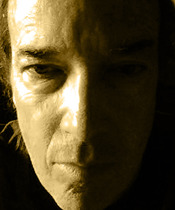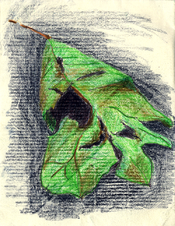 William Theodore Van Doren. Stony Point, Albemarle County, Va. Oil on paper, 16 x 20.
William Theodore Van Doren. Stony Point, Albemarle County, Va. Oil on paper, 16 x 20.
Even though it hasn’t really stopped raining – thanks to the monster nor’easter off the coast – I’m ready with my little aside to The Men Who Stare At Goats.
I’ve learned that some wild ideas I published an article on 28 years ago have come full circle – or maybe it would be more accurate to say, have done an acrobatic loop – and are the basis for the film. Since the ideas were new when I ran the article, and are now being satirized by Hollywood, it may be safe to conclude that they’ve gone through some sort of complete life cycle.
The story was by L.A.-based writer Bill Crandall. This was my intro to his piece, in the August 7, 1981, issue of my poster-sized publication The Wall Paper:
The Los Angeles Reader recently ran a feature story on Army Lt. Col. Jim Channon and his “First Earth Battalion.” The article explains Channon’s concept of a special ‘holistic’ ‘new age’ Army unit of ‘warrior monks’ that would conquer with deadly force if necessary but might also use ‘will’, ‘spirit’ or ‘love’. Although the Battalion does not yet exist as an operational unit, its content and objectives are being developed with the support of the Army command.
As Crandall then explained:
Channon takes himself for the focus of a dialectical synergy between the Pentagon and the New Age folks. He wants to send his soldiers out with “ginseng, amphetamines, megavitamins, herbs, and night-vision [all-natural] foods.” ... These sweeties are also to be armed to the teeth and trained in oriental martial arts. Military lunacy is nothing new, but this man wants to freak out with style, he wants his killing with spice – ritual, he says, after the manner of warpaint and feathers. Tanks blaring Black Sabbath or “something like the sound of a 110-piece black high school band really jiving ... crescendos that go higher and higher.”
When I ran the story, I pretty much decided to take Bill’s word, and the relatively sober reputation of the L.A. Reader, as reason to accept that this concept was actually being entertained by our military. But I did have my doubts. Now I find out, in 2009, it was all true all along – all this, and more. Practitioners of these, how to say, enlightened black arts, were and in some cases still are, associated with our armed forces.
If you go to the website for The Men Who Stare At Goats, to the highly informative and entertaining page by the author of the original book, you learn that there was only one man who actually stared at goats in the First Earth Battalion:
... the goat starer ... says he managed to drop one goat once, although there is no way of verifying this. The goat starer runs a dance studio in Ohio now. When I approached him for an interview I asked him if he was still practicing the technique and he said yes, and only last week he killed his hamster just by staring at it.
Actually, if I were that guy’s hamster, I might have died of a heart attack just thinking about my owner.
As funny as much of the material sounds – an Army general kept expecting to be able to walk through walls because, after all, they’re composed of tiny atoms whirling in space – the endeavor eventually made its way into what the author calls “the most whacked-out corners of George W. Bush’s War on Terror,” into diabolical torture techniques and ideas for remote killing.
Another personal connection with this stuff I didn’t know I had is a lengthy interview I did, for a client’s book, with psychic Joe McMoneagle at The Monroe Institute. I had no idea at the time (early 1990s) that the powers of ‘remote viewing’ he was describing – and he mentioned working with the government – might be used in ‘black ops’ by First Earth Battalion types.
Given these kinds of serious implications, perhaps it’s just as well that the film, overall, is apparently not nearly as entertaining as the cast and crazy material might lead you to hope and expect. One of those that, when the trailer played, my wife and I turned to each other and said, “Seems like we’ve just seen the good moments.”
Meanwhile – no big deal – but I seem to be able to make the sun go down every night by staring at it. Look for the forthcoming film.
 William Theodore Van Doren. Stony Point, Albemarle County, Va. Oil on paper, 16 x 20.
William Theodore Van Doren. Stony Point, Albemarle County, Va. Oil on paper, 16 x 20. Friday, November 13, 2009 at 05:56PM | by
Friday, November 13, 2009 at 05:56PM | by  BVD | in
BVD | in  Sunset Paintings | tagged
Sunset Paintings | tagged  Flint the foxhound,
Flint the foxhound,  Hurricane Ida,
Hurricane Ida,  November,
November,  Rivanna River,
Rivanna River,  rain | | Comments Off
rain | | Comments Off 









